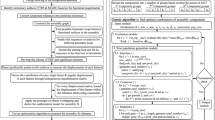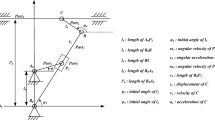Abstract
Manufacturing of high precision assemblies pose a great challenge to engineers. High precision assemblies are generally assembled using selective assembly when the assembly tolerance requirement is less than the sum of the part tolerances. Although extensive research has been done in selective assembly modelling for minimising surplus parts and tolerance variation, they do not suit given specifications. In this paper, a new selective assembly model using a genetic algorithm is proposed to provide a detailed method for assembling parts for achieving specified assembly tolerance with minimum surplus parts. This model provides the best combination of selective groups and the number of assemblies in each group and so the assembly process is simplified. Genetic Algorithm is used to find the best combinations and the number of assemblies in each combination to minimize surplus parts. This paper analyses the effectiveness of the model for given target assembly tolerance for a linear assembly and it can be extended to any type of product.





Similar content being viewed by others
References
Mansoor, E. (1961). Selective assembly – its analysis and applications. International Journal of Production Research,1(1), 13–24.
Desmond, D. J., & Setty, C. A. (1962). Simplification of selective assembly. IJPR,1(3), 3–18.
Allen Pugh, G. (1986). Partitioning for selective assembly. In Proceedings of the 8th annual conference on computers and industrial engineering (Vol. 11, No. 1–4, pp. 175–179), Orlando, FL, USA.
Allen Pugh, G. (1992). Selective assembly with components of dissimilar variance. Computers & Industrial Engineering,23(1–4), 487–491.
Fang, X. D., & Zhang, Y. (1995). A new algorithm for minimizing the surplus parts in selective assembly. Computers & Industrial Engineering,28(2), 341–350.
Kannan, S. M., & Jayabalan, V. (2001). A new grouping method to minimize surplus parts in selective assembly for complex assemblies. International Journal of Production Research,39(9), 1851–1863.
Kannan, S. M., & Jayabalan, V. (2002). A new grouping method for minimizing the surplus parts in selective assembly. Quality Engineering,14(1), 67–75.
Kannan, S. M., & Jayabalan, V. (2002). Manufacturing mean design for selective assembly to minimize surplus parts. In: ICQR (pp. 259–264).
Kannan, S. M., Jayabalan, V., & Jeevanantham, K. (2003). Genetic algorithm for minimizing assembly variation in selective assembly. International Journal of Production Research,41(14), 3301–3313.
Kannan, S. M., Asha, A., & Jayabalan, V. (2001/2002). A new method in selective assembly to minimize clearance variation for a radial assembly using genetic algorithm. Quality Engineering,14(1), 67–75.
Kumar, S., & Kannan, S. M. (2007). Optimum manufacturing tolerance to selective assembly technique for different assembly specifications by using genetic algorithm. International Journal of Advanced Manufacturing Technology,32, 591–598.
Kannan, S. M., Jayabalan, V., & Jeevanantham, K. (2008). Modelling and analysis of selective assembly using Taguchi’s loss function. International Journal of Production Research,46(15), 4309–4330.
Asha, A., Kannan, S. M., & Jayabalan, V. (2008). Optimization of clearance variation in selective assembly for components with multiple characteristics. International Journal of Advanced Manufacturing Technology,38, 1026–1044.
Matsuura, S., & Shinozaki, N. (2011). Shifting the process mean to minimize surplus components and unacceptable products in selective assembly. Journal of Quality,18(2), 87–100.
Fei, Junfeng, Cong, Lu, & Wang, Songling. (2012). Minimizing surplus parts in selective assembly using GA. Applied Mechanics and Materials,215–216(2012), 178–181.
Yue, X., Wu, Z., Tianze, H., & Julong, Y. (2014). A heuristic algorithm to minimize clearance variation in selective assembly. Revista Tecnica de la Facultad de Ingenieria Universidad del Zulia,37(2), 55–65.
Lu, C., & Fei, J.-F. (2015). An approach to minimizing surplus parts in selective assembly with genetic algorithm. Journal of Engineering Manufacture,229(3), 508–520.
Manickam, N., & De, Tarag Nath. (2015). Optimum group size selection for launch vehicle sections linear assembly by selective assembly method. International Journal of Engineering Research and Technology,4, 837–843.
Liu, S., & Liu, L. (2017). Determining the number of groups in selective assembly for remanufacturing engine. Science Direct – Procedia Engineering,174, 815–819.
Sun, W., Mu, X., Sun, Q., & Jiang, Y. (2017). The grouping and matching of three dimensional deviation based on homogeneous transformation and Taguchi theory. Bulletin of the JSME Journal of Advanced Mechanical Design, Systems and Manufacturing,11(1), 1–16.
Wang, W. M., Li, D. B., He, F., & Tong, Y. F. (2018). Modelling and optimization for a selective assembly process of parts with non-normal distribution. IJSIMM,17(1), 133–146.
Jeevanantham, A. K., Chaitanya, S. V., & Rajeshkannan, A. (2019). Tolerance analysis in selective assembly of multiple component features to control assembly variation using matrix model and genetic algorithm. International Journal of Precision Engineering and Manufacturing,20(10), 1801–1815.
Author information
Authors and Affiliations
Corresponding author
Additional information
Publisher's Note
Springer Nature remains neutral with regard to jurisdictional claims in published maps and institutional affiliations.
Rights and permissions
About this article
Cite this article
Kannan, S.M., Raja Pandian, G. A New Selective Assembly Model for Achieving Specified Tolerance in High Precision Assemblies. Int. J. Precis. Eng. Manuf. 21, 1217–1230 (2020). https://doi.org/10.1007/s12541-019-00287-7
Received:
Revised:
Accepted:
Published:
Issue Date:
DOI: https://doi.org/10.1007/s12541-019-00287-7




